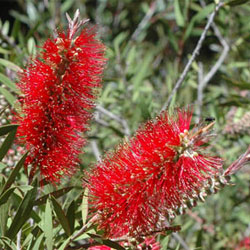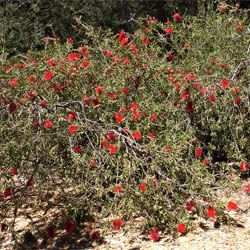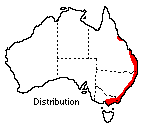Callistemon citrinus
(some herbaria are calling this Melaleuca citrina)
 |
 |
Crimson Bottlebrush
Callistemon citrinus (Curtis) Skeels
Callistemons are found wild only on the Australian continent, but are among the best-known Australian plants grown in other countries where several half-hardy species are widely grown and adaptable to garden treatment. The Callistemon flower with the showy part consisting of massed stamens, not petals, is a novelty in cooler climates, and where the plants will not survive outdoors they are prized as pot plants under glass.
The Crimson Bottlebrush is a shrub from swampy areas of Victoria, New South Wales and Queensland. In cultivation, however, it may reach small-tree proportions if conditions are favourable. It is generally described as bright red, tipped with dark anthers.
 Here and abroad, many beautiful garden forms have been raised and distributed
under this name. As the species crosses freely with others grown nearby it is
likely that some of these are hybrids, bringing in colour variations. In addition
superior forms are often discovered in the bush.
Here and abroad, many beautiful garden forms have been raised and distributed
under this name. As the species crosses freely with others grown nearby it is
likely that some of these are hybrids, bringing in colour variations. In addition
superior forms are often discovered in the bush.
The special attraction of this bottle brush is its habit of flowering twice a year if well watered. In years of extreme heat and cold in Canberra, and lacking water, flowering has been sparse. The main flowering season is from early November, but its autumn flowers are even more welcome from the end of March. The brilliant red looks fresh in late summer heat waves and warm in early winter.
Leaves are flat and stiff and growth is also stiff and dense, made more so by pruning which may be done after the spring flowering or in autumn in frost-free climates; an old specimen pruned for years forms a tough shrub with stringy lower bark. An average height would be 3-4 m. The bottle brush can be used for a large hedge trimmed hard, or trained for a small tree by keeping one stem and staking in early years; for this purpose 4 m would be a good height in Canberra.
The woody seed capsules remain closed on the branches for years and open when taken off and placed in a warm place, such as a sunny windowsill. Seed is plentiful and young plants are easily raised this way. Cuttings of semi-ripe wood can be used to increase specially good forms.
This native plant is easy to obtain and may be planted in any position
or soil including really wet conditions or by the sea. No shrub could
give a more brilliant display for so little trouble. Bees and small birds are
frequently seen around the flowers. In some years the leaves are badly blemished
by a tiny scale which causes a blistered appearance and some twisting, as well
as some attendant smut. To control this a spray of white oil and a sytemic insecticide
can be applied. A repeat spray may be required in fourteen days.
Based on text by ANBG staff (1972)
| Name meaning: Callistemon citrinus
Callistemon - from two Greek words meaning beautiful stamens; citrinus - lemon-scented, of the leaves |
![An Australian Government Initiative [logo]](/images/austgovt_brown_90px.gif)

